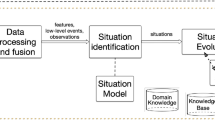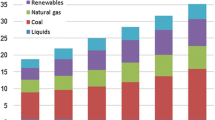Abstract
This paper describes work on the development of an actionable model of situation awareness for Army infantry platoon leaders using fuzzy cognitive mapping techniques. Developing this model based on the formal representation of the platoon leader provided by the Goal-Directed Task Analysis (GDTA) methodology advances current cognitive models because it provides valuable insight on how to effectively support human cognition within the decision-making process. We describe the modeling design approach and discuss validating the model using the VBS2 simulation environment.
Similar content being viewed by others
Explore related subjects
Discover the latest articles, news and stories from top researchers in related subjects.References
Anderson JR (2007) How can the human mind exist in the physical universe? Oxford University Press, New York
Anderson JR, Lebiere C (1998) The atomic components of thought. Lawrence Erlbaum Associates, Mahwah
Anderson JR, Bothell D, Byrne MD, Douglass S, Lebiere C, Qin Y (2004) An integrated theory of the mind. Psychol Rev 111(4):1036–1060
Archer S, Warwick W, Oster A (2000) Current efforts to model human decision making in a military environment. In: Proceedings of advanced simulation technologies conference (ASTC), Washington, DC, Apr 16–20, pp 151–155
Aretz A, Guardino A, Porterfield T, McClain J (1986) Expert system advice: how should it be given? In: Proceedings of the human factors society 30th annual meeting. Human Factors Society, Santa Monica, pp 652–656
Axelrod R (1976) Structure of decision: the cognitive maps of political elites. Princeton University Press, Princeton
Banini GA, Bearman RA (1998) Application of fuzzy cognitive maps to factors affecting slurry rheology. Int J Miner Process 52(4):233–244
Beach LR, Mitchell TR (1987) Image theory: principles, goals and plans in decision making. Acta Psychol 66:201–219
Bolstad CA, Riley JM, Jones DG, Endsley MR (2002) Using goal directed task analysis with Army brigade officer teams. In: Proceedings of the 46th annual meeting of the human factors and ergonomics society. Human Factors and Ergonomics Society, Santa Monica, pp 472–476
Bratman M (1987) Intentions, plans, and practical reason. Harvard University Press, Cambridge
Chignell MH, Peterson JG (1988) Strategic issues in knowledge engineering. Hum Factors 30(4):381–394
Dickerson JA, Kosko B (1994) Virtual worlds as fuzzy cognitive maps. Presence 3(2):173–189
Endsley MR (1988) Situation awareness global assessment technique (SAGAT). In: Proceedings of the national aerospace and electronics conference (NAECON). IEEE, New York, pp 789–795
Endsley MR (1993) Situation awareness: the development and application of a theoretical framework. In: Proceedings of the human factors society 37th annual meeting. Human Factors and Ergonomics Society, Santa Monica, pp 39–40
Endsley MR (1995) Toward a theory of situation awareness in dynamic systems. Hum Factors 37(1):32–64
Endsley MR (2000) Theoretical underpinnings of situation awareness: A critical review. In: Endsley MR, Garland DJ (eds) Situation awareness analysis and measurement. LEA, Mahwah
Endsley MR, Holder LD, Leibrecht BC, Garland DJ, Wampler RL, Matthews MD (2000). Modeling and measuring situation awareness in the infantry operational environment. Tech Report DASW01-99-D-0013
Endsley MR, Bolté B, Jones DG (2003) Designing for situation awareness: an approach to user-centered design. Taylor & Francis, New York
Evertsz R, Pedrotti M, Busetta P, Acar H (2009) Populating VSBS2 with realistic virtual actors. In: Proceedings of the 18th conference on behavior representation in modeling and simulation. U of Central Florida, Orlando
Fan X, Sun S, Yen J (2005) On shared situation awareness for supporting human decision-making teams. In: Proceedings of 2005 AAAI spring symposium on AI technologies for homeland security
Georgopoulos VC, Malandraki GA, Stylos CD (2003) A fuzzy cognitive map apporoach to differential diagnosis of specific language impairment. Artif Intell Med 29:261–278
Gettings ME, Bultman MW, Fisher FS (2004) A complex systems model approach to quantified minderal resource appraisal. Environ Manag 33(1):87–98
Giles BG, Findlay CS, Haas G, LaFrance B, Laughing W, Pembleton S (2007) Integrating conventional science and aboriginal perspectives on diabetes using fuzzy cognitive maps. Soc Sci Med 64(3):562–576
Hobbs BF, Ludsin SA, Knight RL, Ryan PA, Biberhofer J, Ciborowski JJH (2002) Fuzzy cognitive mapping as a tool to define management objectives for complex ecosystems. Ecol Appl 12(5):1548–1565
Huang SH, Endsley MR (1997) Providing understanding of the behavior of feedforward neural networks. IEEE Trans Syst Man Cybern 27(3):465–474
Isak KGQ (2008). Investigating fuzzy cognitive mapping as a participatory tool for conceptual landscape modelling. MSc Thesis in Landscape Management, Faculty of Life Sciences, University of Copenhagen
Jones RM, Laird JE, Nielsen PE, Coulter KJ, Kenny P, Koss FV (1999) Automated intelligent pilots for combat flight simulation. AI Mag 20(1):27–41
Khan MS, Quaddos M (2004) Group decision support using fuzzy cognitive maps for causal reasoning. Group Decis Negot 13:463–480
Klir G, St Clair UH, Yuan B (1997) Fuzzy set theory foundations and applications
Kosko B (1986) Fuzzy cognitive maps. Int J Man-Mach Stud 24:65–75
Kosko B (1987) Adaptive inference in fuzzy knowledge networks. In: Conference on neural networks, vol 2, pp 261–286
Moore H, Galloway J (1993) We were soldiers once and young. Harper, New York
Ndousse TD, Okuda T (1996) Computational intelligence for distributed fault management in networks using fuzzy cognitive maps. In: Proceedings of the IEEE international conference on communications converging technologies for tomorrow’s application. IEEE, New York, pp 1558–1562
Newell A (1990) Unified theories of cognition. Harvard University Press, Cambridge
Özesmi U (1999). Ecosystems in the mind: Fuzzy cognitive maps of the Kizilirmak Delta Wetlands in Turkey, http://env.erciyes.edu.tr/Kizilirmak/UODissertation/uozesmi5.pdf
Özesmi U, Özesmi S (2003) A participatory approach to ecosystem conservation: fuzzy cognitive maps and stakeholder group analysis in Uluabat Lake, Turkey. J Environ Manag 31(4):518–531
Özesmi U, Özesmi SL (2004) Ecological models based on people’s knowledge: a multi-step fuzzy cognitive mapping approach. Ecol Model 176(1–2):43–64
Papageorgiou EI, Groumpos PP (2004) Two-state learning algorithm for fuzzy cognitive maps. In: Proceedings of the IEEE international conference on intelligent systems
Perusich K, McNeese MD (1998) Understanding and modeling information dominance in battle management: applications of fuzzy cognitive maps. Tech Report AFRL-HE-WP-TR-1998-0040
Ritter FE, Kase SE, Bhandarkar D, Lewis B, Cohen MA (2007) dTankUpdated: exploring moderated behavior in a light-weight synthetic environment. In: Proceedings of the 16th conference on behavior representation in modeling and simulation (BRIMS). U of Central Florida, Orlando
Schank RC, Abelson RP (1977) Scripts, plans, goals and understanding. Erlbaum, Hillsdale
Selcon SJ, Bunting AJ, Coxell AW, Lal R, Dudfield HJ (1995) Explaining decision support: an experimental evaluation of an explanatory tool for data-fused displays. In: Proceedings of the eighth international symposium on aviation psychology. The Ohio State University, Department of Aviation, Columbus, pp 92–97
Shively RJ, Brickner M, Silbiger J (1997) A computational model of situational awareness instantiated in MIDAS. In: Proceedings of the ninth international symposium on aviation psychology, Columbus, Ohio
Siraj A, Bridges SM, Vaughn RB (2001) Fuzzy cognitive maps for decision support in an intelligent intrusion detection system. North American Fuzzy Information Processing Society
Skogoey KI, Skov F (2007) Fuzzy cognitive mapping—a model for public participation. In: Chmielewski TJ (ed) Nature conservation management: from idea to practical results. ALTER-Net, Lublin. ISBN: 83-87414-98-0. [Cited on 25.09.08]. Available at the internet:http://www.alternet.info/POOLED/ARTICLES/BF_NEWSART/VIEW.ASP?Q=BF_NEWSART_300866
Skov F, Svenning JC (2003) Predicting plant species richness in a managed forest. For Ecol Manag 180(1–3):583–593
Smith E, Eloff J (2000) Cognitive fuzzy modeling for enhanced risk assessment in health care institution. IEEE Intell Syst Appl 2000:69–75
Strater LD, Endsley MR, Pleban RJ, Mathews MD (2001) Measures of platoon leader situation awareness in virtual decision making exercises. Research Report 1770, Army Research Institute, Alexandria, VA
Taber WR (1991) Knowledge processing with fuzzy cognitive maps. Expert Syst Appl 2(1):83–87
Tan CO, Özesmi U (2006) A generic shallow lake ecosystem model based on collective expert knowledge. Hydrobiologia 563:125–142
Walters B, Yow A (2000) An evaluation of task network modeling for use in simulating situation awareness. In: Proceedings of the IEA 200/HFES200 congress. Human Factors and Ergonomics Society, Santa Monica
Winston PH (1992) Artificial intelligence (3rd edn). Addison-Wesley, Reading
Xirogiannis G, Stefanou J, Glykas M (2004) A fuzzy cognitive map approach to support urban design. Expert Syst Appl 26:257–268
Zachary W, Le Mentec J-C (1999) A framework for developing intelligent agents based on human information processing architecture. In: Proceedings from IASTED international conference ASC.
Author information
Authors and Affiliations
Corresponding author
Rights and permissions
About this article
Cite this article
Jones, R.E.T., Connors, E.S., Mossey, M.E. et al. Using fuzzy cognitive mapping techniques to model situation awareness for army infantry platoon leaders. Comput Math Organ Theory 17, 272–295 (2011). https://doi.org/10.1007/s10588-011-9094-6
Published:
Issue Date:
DOI: https://doi.org/10.1007/s10588-011-9094-6




